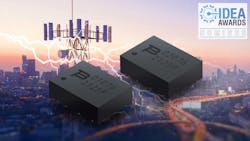Power TVS Device Puts High-Voltage Protection in a DFN Package
Check out the other 2023 IDEA Award Nominees. This article is also part of the TechXchange: Power Supply Design.
Virtually every power supply that connects to direct current (DC) and alternating current (AC) power lines requires some form of protection against high-voltage transients or other hostile power surges.
In applications that require a high degree of protection and more accurate control, it can make sense to use a class of circuit-protection device called a power transient-voltage-suppressor (PTVS) diode.
These devices are designed to limit peak voltages without short-circuiting the system during a power surge—frequently the result of lightning strikes, inductive switching, or high-voltage transients. These events can impair microprocessors, sensors, and other electronics, or even cause severe damage to the system. Excess voltages also pose a threat to humans by increasing the risk of electrical shock.
Bourns is trying to stay a step ahead of circuit-protection requirements with its PTVS1 and PTVS2 series, which can suppress surges of current of up to 1 and 2 kA (8/20 μs) in compact DFN packages.
Designed to clamp hazardous high voltages and dissipate excess energy, the PTVS1 has a normal operating or standoff voltage of 22 to 86 V and protects against currents of up to 1 kA. The parts are also said to deliver very low clamping voltage under surge conditions while keeping inductance to a minimum on the power line. Moreover, they can operate reliably over a wide range of temperatures.
During regular operation, when the voltage traveling through the system stays within the standoff voltage, the power TVS must not interfere with signals or power traveling the line. When the voltage rises to the point where it can cause a sudden rush of current or damage to be done to the system—also called “breakdown” voltage—the device is designed to turn itself on.
In the event the voltage spikes, the power device clamps down and diverts the surge of current into itself. At that point, the part dissipates the excess energy to avoid any serious damage.
Bourns said the PTVS2 series stands out from other overvoltage-protection devices on the market with its uniquely high degree of protection against power surges. The parts can tolerate up to 2 kA.
Compact PTVS
A power TVS reduces the impedance over the protected line to attempt to limit or regulate voltages and, thus, reduce the time systems stay down after being overloaded. The devices conduct current while maintaining a high voltage on the line, leading to very high levels of power dissipation. Despite having high current and voltage ratings, the tradeoff is that they must be placed in larger packages.
The company addresses that tradeoff with the new PTVS1 and PTVS2 series, which can handle very high voltages in a surface-mount DFN package that measures only 8 × 6 × 2.5 mm.
Consequently, the new power devices use up to 50% less space on the circuit board than existing devices, which are usually housed in bulky over-molded or through-hole packages, said Bourns.
The smaller form factor of the PTVS1 and PTVS2 not only saves valuable space on the PCB, giving you the flexibility to add more features to a system, but it also reduces bill-of-materials (BOM) costs.
In addition, the parts are bidirectional, with both positive and negative breakdown voltages. Thus, they can be placed between the input and ground to direct dangerous current out of a system.
Overvoltage events vary widely in terms of intensity. In addition to lightning strikes, a voltage spike can even be caused by a light electrostatic-discharge (ESD) event, which the PTVS1 and PTVS2 series can also protect against. The new parts are rated to IEC 6100-4-2 Level 4 for ESD protection.
Check out more 2023 IDEA Award Nominees. Also, read more articles in the TechXchange: Power Supply Design.
About the Author
James Morra
Senior Editor
James Morra is the senior editor for Electronic Design, covering the semiconductor industry and new technology trends, with a focus on power electronics and power management. He also reports on the business behind electrical engineering, including the electronics supply chain. He joined Electronic Design in 2015 and is based in Chicago, Illinois.

